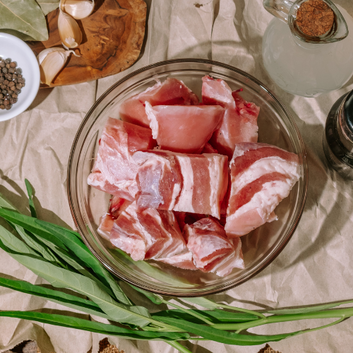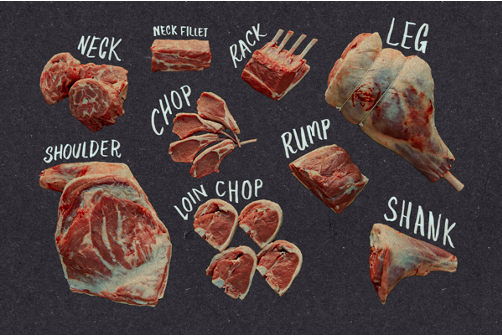Grass Fed Meat
Grass fed meat MUST be cooked differently.
This applies to beef, bison, pork, lamb, and ground meat
This applies to beef, bison, pork, lamb, and ground meat
Thaw completely. This is best done in the refrigerator. Covered. Do not thaw using a microwave.
Bring meat to an even temperature throughout prior to cooking. Room temperature is best but keep the meat covered.
Always pre-heat your oven, pan or grill before cooking grass-fed meat.
30% less cooking time is typical because of our higher protein levels and lower fat content.
If using an oven, lower the oven temperature by 50°F when using your recipes.
Grass-fed steaks are most succulent when eaten rare to medium-rare.
It is seldom if ever necessary to “brown” or per cook grass-fed meat. Browning almost always means overcooking.
Use an instant-read thermometer.
 The yellow color of Grass-fed fat comes from Beta-carotene (vitamin A) which is found in grass. Left in the photo. Corn fed beef is a nutrient deficient white. Right in the photo.
The yellow color of Grass-fed fat comes from Beta-carotene (vitamin A) which is found in grass. Left in the photo. Corn fed beef is a nutrient deficient white. Right in the photo.
Grass-fed meat continues to cook even after it has been removed from the heat.
Finished temperatures of 125° F – Rare (Best); 130° F – Medium Rare (OK); 135° F – Medium.
Keep it tender and juicy. Lightly coat the cuts with extra virgin olive oil then season.
Cook it “low and slow.” Cooking over lower heat retains moisture.
Let it rest for 6-10 minutes allows the precious juices to be redistributed within the relaxing meat.
NOTE: The meat should always be juicy with a pink center when served. The red liquid that should still be present inside the steak or roast (and on the serving plate) is not blood. It is myoglobin in water a protein constituent of healthy red meat.
Gail says, “ If it is almost done, it is done”. Cooking “Just a little more”, always leads to overcooking.
Finished temperatures of 125° F – Rare (Best); 130° F – Medium Rare (OK); 135° F – Medium.
Keep it tender and juicy. Lightly coat the cuts with extra virgin olive oil then season.
Cook it “low and slow.” Cooking over lower heat retains moisture.
Let it rest for 6-10 minutes allows the precious juices to be redistributed within the relaxing meat.
NOTE: The meat should always be juicy with a pink center when served. The red liquid that should still be present inside the steak or roast (and on the serving plate) is not blood. It is myoglobin in water a protein constituent of healthy red meat.
Gail says, “ If it is almost done, it is done”. Cooking “Just a little more”, always leads to overcooking.
Tips for Cooking Pastured Pork.

NOTE: The new USDA guideline recommends cooking pork to 145 degrees maximum, same as beef or bison. Particularly important for pork steaks and chops. That is a big change from what your mother told you.
Most meats are ideal at rare to medium-rare temperatures, including pork. Meat is likely to be tougher and less flavorful when cooked past medium rare, (145 degrees). . If you prefer meat well done, cook at a low temperature in a sauce to add moisture. A slow cooker is ideal.
Never use a microwave to thaw meat. Either thaw in the refrigerator or, for quick thawing, place the sealed package in cold water for a few minutes. Let it sit at room temperature for no more than 30 minutes. Don’t cook it cold straight from the refrigerator.
Always pre-heat the oven, pan, or grill before cooking pastured pork.
Grass-fed meats cook faster. Use a thermometer to test for doneness and watch the temperature carefully. You can go from perfectly cooked to overdone in less than a minute. The meat will continue to cook after you remove it from the heat, so when it reaches a temperature ten degrees LOWER than the desired temperature, it’s done. Do not cook past 145 degrees. The new USDA guideline recommends cooking pork to 145 degrees maximum.
Let the meat rest, covered, on a warm plate for eight to ten minutes after removing from heat to let the juices redistribute.
When grilling, quickly sear the meat over high heat on each side and then reduce the heat to medium or low to finish. Baste to add moisture.
Never use a fork to turn the meat. Always use tongs.
When roasting, sear the meat first to lock in the juices and then place in a pre-heated oven. Reduce the roasting temp by 50 degrees F.
Most meats are ideal at rare to medium-rare temperatures, including pork. Meat is likely to be tougher and less flavorful when cooked past medium rare, (145 degrees). . If you prefer meat well done, cook at a low temperature in a sauce to add moisture. A slow cooker is ideal.
Never use a microwave to thaw meat. Either thaw in the refrigerator or, for quick thawing, place the sealed package in cold water for a few minutes. Let it sit at room temperature for no more than 30 minutes. Don’t cook it cold straight from the refrigerator.
Always pre-heat the oven, pan, or grill before cooking pastured pork.
Grass-fed meats cook faster. Use a thermometer to test for doneness and watch the temperature carefully. You can go from perfectly cooked to overdone in less than a minute. The meat will continue to cook after you remove it from the heat, so when it reaches a temperature ten degrees LOWER than the desired temperature, it’s done. Do not cook past 145 degrees. The new USDA guideline recommends cooking pork to 145 degrees maximum.
Let the meat rest, covered, on a warm plate for eight to ten minutes after removing from heat to let the juices redistribute.
When grilling, quickly sear the meat over high heat on each side and then reduce the heat to medium or low to finish. Baste to add moisture.
Never use a fork to turn the meat. Always use tongs.
When roasting, sear the meat first to lock in the juices and then place in a pre-heated oven. Reduce the roasting temp by 50 degrees F.
Lamb Cut and Cooking Guide.
Keep in mind that a lamb carcass is much smaller than a beef or hog carcass. The individual cuts are relatively small. The total amount of meat from a ½ lamb is not great. Consider it as the delicacy it is.
Lamb is a great source of protein, vitamins and minerals.
SHOULDER
This part of the animal works hard, so the meat from a lamb’s shoulder is full of flavor. It takes a while to become tender, but this means it’s a great choice for stewing and slow-roasting. To maximize the flavor, cook lamb shoulder on the bone so the meat simply falls apart when pulled with a fork. Recipes using lamb shoulder are fail-safe crowd pleasers. Do a slow cooked shoulder for a perfect Sunday. To keep things super simple, make an herb rub with some mint or rosemary, garlic, sea salt, black pepper and olive oil, slash the skin of the meat and massage the rub into all its nooks and crannies. Sit it on top of wedges of onion, add some liquid, cook on a high temperature to get the skin lovely and golden, then cover and turn down to low (around 160ºC) for 4 to 5 hours (depending on the weight of the shoulder)
CHOP/RACK
Lamb chops or cutlets are the most expensive cuts of lamb, but are incredibly delicious and tender. They are taken from the ribs of the lamb and cooked individually, normally over a grill or a barbecue. When several are left together and cooked as a whole, they are called a rack of lamb. Best served pink, they are amazing.
LOIN CHOP
These are mini T-bone steaks cut from the waist of the lamb. On one side of the chop is the lamb loin and on the other side is the fillet. Just like chops, they’re great for grilling or barbecuing – serve with a Middle Eastern vibe or marinate. Serve with harissa-spiked humous to embrace delicious Moroccan flavors.
RUMP
The rump comes from the back of the lamb. This cut is lean, tender and full of flavor. Be careful not to overcook as it will become tough if left to dry out. It is delicious pan-fried whole, finished in the oven for a few minutes, then sliced to reveal its blushing pink center. Or, it can be cut into chops on the bone then grilled or pan-fried.
LEG
Like the shoulders, the legs of a lamb work hard, which means that this cut has a good, strong flavor. Leg of lamb is great roasted whole on the bone, or boned and barbecued. It’s a fairly lean muscle, so take care not to overcook it, or else it could end up quite dry. Rub it all over with an herb oil, some garlic and even a little mustard, if you like, roast in the oven, then finish off on the barbecue to get a great gnarly smoked flavor.
SHANK
Lamb shank is a super-simple, cheaper cut that goes a long way. Taken from the lower part of the back legs, there is a lot of collagen in the shank, which, when cooked slowly, gives the meat a lovely soft, melting texture, making this another cut that’s perfect for stews and slow-cooking.
NECK
Lamb neck can be cooked slowly on a low heat, yet unlike the shoulder, it can also be treated like a steak and cooked quickly over a high heat until pink. It goes well with a whole load of flavors and is delicious served when cooked low and slow. It works well as a stew or curry and is a great cut of meat to make kebobs with, too.

